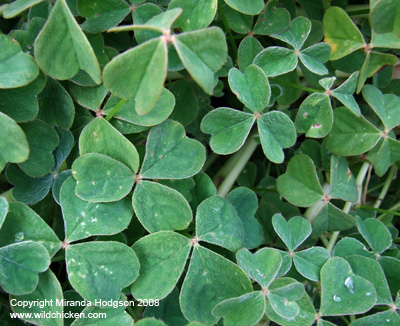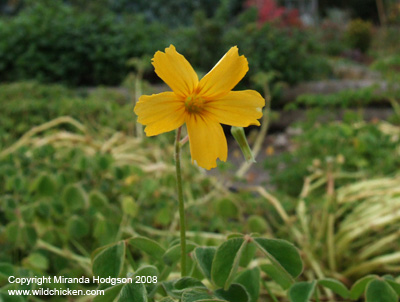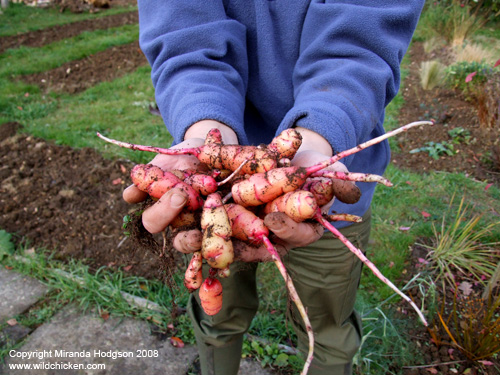Growing Oca (Oxalis tuberosa) in the UK

Oca (Oxalis tuberosa) tubers
There is more information about growing Oca (Oxalis tuberosa) here.
We tried a new vegetable this year, Oca, or Oxalis tuberosa. A pink cylindrical tuber, it’s a South American root crop which was for a long time second only in importance the potato.
Although it isn’t grown as much today, Oca is still popular in South America and it is now making its way to Europe, via New Zealand, where it is known as the New Zealand yam.
We became interested after seeing them for sale on a website and couldn’t resist buying a few to see what they tasted like and how easy they were to grow. Oca aren’t cheap, we paid about £1 a tuber, small tubers too. They were fine stored in a cool and dim garage, from late November to the beginning of March, when we brought them into a lighter room so that they would sprout.
Although the tubers started to look pretty wrinkled, they all sprouted and within a month or so were ready to go into 10cm pots of moist compost. We looked often to see if the first leaves were poking through the surface yet and, as anyone who grows something for the first time knows, it felt a long and vexatious wait.
They did come through, finally, and once they got to about 10cm high, and the danger of frost had passed, we reckoned they were ready to go into the ground in beds that had been dug over some weeks beforehand.
One small Oca tuber can produce a surprising amount of foliage so they need a good bit of space, and should be planted about 1m apart. We mulched all round the plants with a thick layer of compost to keep the soil moist and allow nutrients to seep down around the roots.
They grew slowly for the first couple of months, and we wondered if they would put on much growth, but come mid-summer, they suddenly took off. The stems, which had started out quite upright, were suddenly nearly a metre long and keeled over. This concerned us a bit, but it seems to be normal and the stems looked healthy, so we let them get on with it.

Oca (Oxalis tuberosa) foliage
Then, just as the plants were coming on so healthily, we had to move. What to do with the Oca? Well, we weren’t going to just leave them, that’s for sure, so we scouted about for the largest pots we could find, carefully dug them up with as much soil that we could, and transferred them to containers. Not the best thing to do in the middle of the growing season; imagine digging up your potato plants when they’re about to form tubers. It sounds like a recipe for disaster.
At their new home, we gave them a good watering, clustered the pots together and hoped for the best. They carried on growing and even started forming flowers, quite pretty yellow ones that stand above the foliage. We took care to water them when it was dry but otherwise pretty much left them to grow. In their new position, we noticed that a few pretty yellow flowers were produced, but none of these set seed.

Oca - Oxalis tuberosa - flower
Oca don’t start to produce tubers until day and night are equal length and since this falls at a time when early frosts can be an issue, you need to keep an eye on the forecasts and give the plants protection as the foliage is frost tender. We did keep an eye on the forecasts but somehow missed out on the one night when it got really cold and the plants got frosted.
Going up to the garden again, we found a mass of rather mushy-looking foliage and reckoned that the plants were done for. Of course, I hadn’t read at that point, that you can leave the tubers to swell more in the ground and we diligently tipped all the pots out and separated the tubers.
To our surprise, having moved them half way through their growth cycle and then harvesting them a tad early, they’d actually done pretty well and we counted an average of 30 tubers a plant. About a third of these were a decent size and nearly all of them were of the same size or bigger than the seed tubers that we’d received through the post, so we felt really quite pleased.
Not having many to waste, I immediately packed some into two small parcels and sent them to friends who I know will grow them. That left enough for us to grow for next year and a few to sample.
We allowed ourselves three of the larger tubers. I boiled them for about ten minutes, after which they had lost a good bit of their pinkness and were looking a lot like Pink Fir Apple potatoes. Scooped out of the water, we left them to cool for a couple of minutes before the first slice was cut. The skin had come slightly loose and the layer of tuber beneath was a little mealy and very much like potato. The inside was more waxy and had a faint hint of lemon to it. All in all it was very good and a lot like the descriptions we’d read, of a slightly lemony potato.
Although they have a long growing season Oca are certainly worth growing for their tastiness and their not being susceptible to blight. We shall definitely try them again next year.

Oca - Oxalis tuberosa - tubers after harvest
© Copyright Miranda Hodgson 2008